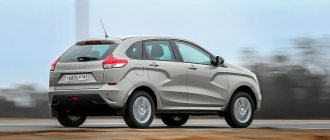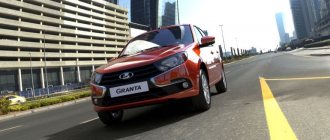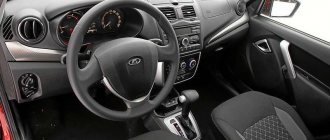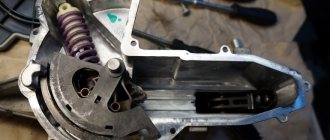Ground clearance
Ground clearance has never been a problem even for the regular Xray. In the Cross version it has grown to an impressive 215 mm. The figure is decent for many all-wheel drive vehicles and is comparable to those of models such as the related Renault Duster or Kaptur. The increase in ground clearance was the result not only of changes in the suspension, but also of a different wheel size. Add to this the unpainted plastic around the perimeter, and the Lada XRAY Cross becomes a good choice for driving off asphalt.
Appearance
If we talk about off-road body kit, then XRAY Cross is a vivid example of how “armor” can benefit the image. The Cross really looks much more harmonious than the usual Xray: unpainted plastic unloaded the heavy image. The 17-inch wheels were also a plus. True, on a rough road, as our Karakum run showed, shoes should still have a higher profile. The roof rails also contribute to the attractive appearance, giving the car a utilitarian look.
New options and features
Lada XRAY Cross boasts a number of new options. First of all, this concerns steering wheel heating - this is the first time such a useful option has appeared in our country on Ladas. And the rim itself can be covered with leather. On the Cross, the front seat heating buttons have finally moved from the end of the seats to the center console. The front seats have been redesigned and have more developed lateral support. The steering wheel now has reach adjustment. And the instrument cluster changed the color of the on-board computer display.
Xray Cross car configurations
According to the manufacturer, it is planned to release one configuration, which will be divided into 2 conditional ones.
The main difference is the use of 2 types of gearboxes
The buyer can choose and add additional functions depending on the need: a standard 5-speed manual transmission or a 5-speed robot made on the basis of a manual transmission.
Distinctive features of the configurations include various options in the form of heating, electrical adjustments and an audio system
Lada Ride Select
Of course, the “off-road” version of Xray, like Vesta, does not have all-wheel drive. And it is unlikely to happen. But this modification still has some alternative. This is the Lada Ride Select system, which allows you to select one of five driving modes. It is also possible to disable the traction control system. There is also a sport mode, which sharpens the response to pressing the accelerator, and a “snow/mud and sand” mode, which not only changes the accelerator settings, but also allows a greater degree of slipping. We were able to fully test the latter mode in the Karakum sands. Of course, it will not replace all-wheel drive, but it will allow the car to move several tens of meters further than a regular XRAY.
As many as 5 driving modes
- ESC On – after starting the engine, this mode is activated by default. It is designed to maximally protect the driver from an accident when driving on roads of questionable quality or in bad weather conditions.
- ESC Off – at 54 km/h the ESC system is switched or, more simply put, turned off (Off). Stability and traction control are disabled.
- Sport - the wheels get more freedom from the traction control system. The gas pedal is actually activated by a light touch, and other modes are deactivated.
- Snow/mud - the drive wheels become the centerpiece for additional load. More wheel slip occurs for the braking system to reduce speed more effectively.
- Sand - the drive wheels are maximally freed from various types of electronic restraint (slippage increases). ABS adapts as much as possible to the effective slipping of the drive wheels.
Chassis
In addition to many updates in the cabin and the appearance of the Lada Ride Select system, Xray Cross also underwent modernization of the chassis. The front suspension arms are similar to West's. It also comes with electric power steering. And, of course, disc brakes on all wheels. All this inevitably affected driving performance. The XRAY Cross rides on a winding road much nicer and clearer than the regular XRAY. Reactions to the steering wheel have become more accurate, and early drift of the front axle when overspeeding has disappeared. And an endless number of vibrations and shocks on uneven roads are no longer transmitted to the steering wheel.
First test drive of Lada Xray Cross. Extraordinary Cross
Lada Xray Cross is a new phrase in the line of VAZ crossovers. Compared to ordinary Xrays, Cross stands out with its ground clearance increased from 195 to 215 mm, unpainted plastic along the lower perimeter of the body and 17-inch wheels with Continental tires. But it turned out that the visible elements of the update are just the tip of the iceberg. “Under the water” are improved interior ergonomics and a modernized chassis. By the way, it’s not so simple with tires either. Universal or, more simply put, “all-season” tires Continental 215/50R17 were developed by German tire makers specifically for the Xray Cross. Nowadays, at AvtoVAZ, everything is not simple.
17-inch wheels, plastic body kit and silver roof rails. That's all the external differences from the usual Xray. Well, also the color “Amber” and the ground clearance, which added 2 cm
Cross is a fashionable theme for Tolyatti. Largus, the Kalina/Granta family and Vesta in station wagon and sedan bodies have already been dressed in plastic armor. Representatives of AvtoVAZ provided the following data: among Largus, the Cross version accounts for 38% of demand, Vesta’s raised cross-sedan managed to “pinch off” 10% of the market in a short time, and the SW station wagon – almost 60%. It’s even strange that in such optimistic situations, the queue for the cross-update reached Ixray one of the last. After all, this is the most crossover model in its essence.
The dimensions have changed: plus 6 mm in length, 46 mm in width and 75 mm in height. At the same time, the crossover looks more proportional
Let us remind you that the Lada Xray is from a family of cars created on the B0 platform, within the framework of the Renault and AvtoVAZ alliance. Duster, Sandero, Logan, Xray, these models have many common components. And as a result - general shortcomings. In Tolyatti they are well aware of the weak points of the platform and especially those nuances that the Xray inherited from the Sandero without changes: a short wheelbase, cramped conditions in the second row, chunky front seats, a steering column that is not adjustable for reach... The list is incomplete. You can come to terms with it, or you can try to fix it. The belated release of Xray Cross is explained by the fact that the VAZ team decided to thoroughly “finish” the imperfect B0. Eliminate problem areas. If not all, then at least the key ones.
Two-tone painting makes the interior more elegant and even colorful. You can choose a color when ordering a crossover in the maximum trim levels Luxe and Luxe/Prestige
A steering column without reach adjustment is probably the most serious of the problems. Coupled with an uncomfortable chair, it turned a person back into an embryo forced to sit crooked. Moreover, there is no alternative - close to the steering wheel. In the X-ray Cross, a telescopic mechanism with a reach of 42 mm is implanted into the steering column. Not much, but quite enough to finally straighten your limbs and body and sit down on your hands. Thank you for such necessary millimeters!
The pillow is embossed, with pliable filling. The back is straight. But the main thing is that the column can now be pulled out towards you. Formally, the updated rear sofa promises more space in the knees, but you can only notice the difference by placing two crossovers side by side
Thanks for the new front seats. They have the optimal back shape, pillow length and overall shape. For a long time, VAZ workers could not decide on the width of the side support rollers. Should I space it wider or narrower? Make it softer or harder? In the end, we settled on a universal measure, suitable for drivers of different builds: the bolsters are not too wide, but at the same time, their filler is pliable and takes the shape of the body under load. We hit the nail on the head. A driver of average height does not experience any discomfort in the new seats.
The installation of new seats entailed alteration of the plastic lining of the B-pillar. It was made less voluminous
However, these seats are wider than before and the space between the body pillar and the backrest adjustment lever has become even smaller. The hand doesn't fit through - journalists complain. The factory workers shrug their shoulders - they changed the upholstery of the B-pillar, now the plastic almost touches the metal. We can say that we squeezed out the free space to the maximum.
The “puck” for selecting off-road modes of the Lada Ride Select system has a clear similarity with Pezhov’s Grip Control system. But the main thing is that the electronics work and are useful. This is most clearly noticeable in freshly fallen snow. The Xray Cross with the activated stabilization system drives up a slippery slope with great effort. But he still stops by. If you turn off the electronics completely by turning the “puck”, the crossover will immediately stall in the middle of the climb. And if you turn on the “Snow” mode, it will confidently take off and accelerate uphill
In exactly the same way, drop by drop, they “filtered” the space on the second row. The sofa was moved closer to the rear axle to increase knee space. At the same time, the back stood two degrees more vertical, the landing became more direct. Although, sitting in the “gallery”, you don’t notice any particular inconveniences. As well as a significant increase in free space in the knees. The second row of the Xray Cross is still a bit cramped.
Heated seats, steering wheel and windshield are current equipment for Russia. It’s a pity that it is included in fixed configurations and cannot be purchased separately
The modified rear sofas also began to be installed on “just Xray”. But you shouldn’t expect a reach-adjustable steering wheel and new front seats yet. It’s too expensive, VAZ people say. This will lead to an increase in the cost of the crossover. In addition, it seemed to me that the factory workers deliberately place the crossover modifications at different angles. For Xray, some of the innovations are held back, while “Cross” gets all the most advanced.
Three-mode heated front seats with automatic reduction of heating intensity
Heated rear sofa, for example. This is not promised to an ordinary Xray. As well as heated steering wheel around the entire perimeter of the rim and windshield over the entire area. Cross has it all. If we go into the “warm” details, the front seats are heated by three-mode heating pads. Moreover, as it heats up, the automation itself will reduce the intensity to “one light bulb”. The minimum mode does not overheat the “fifth point” - the chair is slightly warm. This type of heating is designed for long-term use.
The luggage compartment volume has not changed - 361 liters. In addition to the two-level floor, there is lighting, a socket and hooks for securing cargo. Under the floor there is a full-fledged R17 spare wheel on an alloy wheel
What does this mean? The fact that the factory not only installed heated front seats, but also carried out tests and measurements. In general, we've set it up. As they say, it’s a small thing, but it’s nice. And is it a small thing? When at the presentation it was said that the Xray Cross’s containers and pockets in the cabin were illuminated, I thought that this was another whim. My grandfather’s Zhiguli never had anything like this, and I don’t need it. But it got dark outside. I've been driving for six hours already. I ask my partner - where is the water bottle? Yes, here it is, standing in the door pocket with unobtrusive LED lighting. In the box under the center console it is easy to find chocolate bars and a “mobile phone” - there is also a flashlight.
A car, like a person, is known in the details. It is from these small mosaics that the overall impression is formed. There are no noticeable mistakes in the quality of assembly in the Cross, but the workmanship of small parts is at least no worse than that of foreign cars
You open the door, getting out of the car, and the dirty puddle on the asphalt is illuminated by another special lamp - you won’t accidentally step on it. Finally, there is a two-level trunk, where there is an inconspicuous hook that holds the false floor in the open position. This kind of attention to detail warms the soul. You understand that the people who made this car don’t care. They are interested in going into details, thinking about it, and customizing it.
It's also fun to draw. At dinner I found myself at the same table with the main VAZ artist, Steve Mattin.
— The Cross has completely new front and rear bumpers. — The designer opens a photo of the new crossover on his smartphone. — Black plastic in the lower part, silver inserts... What is less striking is that now the X-shaped stampings on the sidewalls have been continued. Do you see a bumper with the same plastic?
Redesigned front and rear bumpers. Plastic trims on the fenders and sills are fixed with clips and double-sided tape. There is now a cornering light feature that uses standard fog lights
Blue shirt, trousers, a typical “German” forelock (although the chief designer of AvtoVAZ is from Britain - editor's note) on a light head. Mattin is a cool guy. Modern, on trend. But like all geniuses, the little one is not of this world - he has a subtle nature. He admitted that he drives a Lada Vesta SW Cross in “Mars” color around Moscow, and separately clarified: with a manual transmission. Like, I am for a direct relationship with the car, regardless of traffic jams. For which he was awarded cheers and hooting.
He also told me something about work.
The steel pattern on the sides is continued in plastic. Small stampings on the bumpers are a special pride of Steve Mattin
— We call these sharp stampings on the sidewalls “shark fins.” They are clearly visible on the rear pillar of the Vesta SW station wagon. The same contours, but turned 45 degrees, adorn the sidewalls. On the Cross, the X-idea is emphasized by the new bumper design. And pay attention to the large 17-inch wheels...
I tried in vain to see the “shark fin” in the rear pillar of the Vesta station wagon until I realized that the “shark” was swimming against the traffic. Yes, indeed, it seems...
In Steve Mattin's sketches, like many other designers, all cars are distinguished by disproportionately large wheels with thin rims of low-profile tires. Why do they look like cars from comic books? If it were up to him, the Xray Cross would have been fitted with 18-inch wheels (and this option was actually discussed), although 17 inches is a lot for a B-class crossover.
Several sketches date back to 2015, the same year the production of Xrays began. This means that there were cross-ideas already then
At AvtoVAZ, Mattin is allowed, if not everything, then a lot. For example, increase the track of the front and rear wheels so that they are closer to the arches - this way, according to the designer, the car looks more powerful and dynamic (the author of the article completely agrees with the master). On the Cross, the front wheels are 19 mm wider than those on regular Xrays, and the rear wheels are as much as 54 mm wider. Behind these numbers are an upgraded subframe, original L-shaped arms and front suspension steering knuckles, new shock absorbers with springs and many minor improvements. They did a great job of drawing it!
The declared ground clearance - 215 mm - is not entirely correct. The VAZ team measured the ground clearance from the steel cross member, but below it is the third engine mount. Below it - 205 mm
The key figure in this story is 43 mm: the rear axle of the Xray Cross is that much wider than the front, namely 1546 versus 1503 mm. With a wheelbase of 2592 mm, the result is almost a square with excessive agility. In our usual automotive understanding, a passenger car with such parameters is doomed to unstable behavior on a straight line and in turns, front end drifts, but more often slipping of the rear axle due to an increase in its angular rigidity and a short wheelbase. It's like running a cross-country race in beach sandals.
The new subframe and control arms are clearly visible from the front. Shock absorbers with increased rebound/compression strokes. Curiously, the rear springs of the crossover are stiffer than the front ones: 35.5 N/mm versus 31
However, on the move, nothing like this happens with the Cross. The Lada holds a straight line quite firmly. It wiggles only a little when the asphalt moves in waves. You can drive “relaxed”, slightly pressing the gas pedal, or you can bludgeon, attacking turns. The Xray Cross stands firmly on the arc with medium roll and neutral understeer. Having reached the limit of tire grip, the rear axle becomes a little more active, trying to slip. The moment the tires lose traction with the asphalt is clearly felt, but if you do not have time to fend off a skid with the steering wheel, the strictest stabilization system immediately intervenes. Xray project director Oleg Grunenkov says that the tightened ESP “collar” is a necessary measure.
Electronics can be turned off completely. But only up to 48 km/h. Once this threshold is exceeded, the “shackles” will snap back into place by default.
Grunenkov is 46. In Togliatti since 1989, at AvtoVAZ he completed an institute internship. Consider your whole life at the factory. By the way, he has the award “For Services to the Fatherland”, 2nd degree. Oleg Evgenievich himself considers himself more of a manager than an engineer, but he knows the hardware of Xray Cross with a plus.
— You correctly noticed about the rear track of the Cross - it is significantly wider than the front. Because of this, there were difficulties in adjusting controllability. But nothing, we managed...
Previously, Grunenkov led the Lada Kalina and Lada Granta projects. Today he is responsible for Lada Xray
Of course, Grunenkov is being modest. I am sure that tuning the chassis was not easy for him and his specialists. Suffice it to say that among production cars such a significant difference in the width of the front and rear axles is rare and mainly on rear-wheel drive sports cars. The rear-engine Porsche 911 comes to mind, where the wide rear axle compensates for suboptimal weight distribution.
Two-tone painted wheels are produced in Krasnoyarsk. When selecting components, Grunenkov set a task: a 17-inch wheel assembly should weigh no more than a 16-inch one. The suppliers did it right: the new one turned out even a little lighter than the old one
It’s nice that despite the reliable and even combative nature of the Xray Cross’s handling, the smoothness of the ride remained at a quite high level. Tested in extreme conditions on the twisted paths of the Kazakh steppes. If you don’t feel sorry for yourself and your partner, you don’t have to slow down even before the jumps. On landing, the Cross’s suspension will select the entire compression stroke, but there will be no hard impact. Passengers, of course, are unhappy, but in a regular Xray it would be even worse for them. There are more energy-intensive shock absorbers with increased travel, which at the same time eliminate the “goat” of the rear and the rocking of the stern when driving on uneven asphalt.
The elastic elements take the first blow from the unevenness. Only the residual echo of vertical loads reaches the cabin. And this is on 17-inch wheels!
I liked the settings of the electro-hydraulic power steering. Zero is clear, but unobtrusive. And as soon as you tilt the steering wheel even a degree, a thin stream of feedback begins to run along the rim. Its flow increases with the angle of rotation. When taxiing quickly, the amplifier does not bite. In general, it’s a well-tuned “amp.” Import? It turned out that the unit was supplied from Kaluga.
The steering wheel is neither sharp nor dull, neither light nor heavy. Provides feedback, but not too much
Everything would be fine... if not for the engine. On paper, this is 122 power and 170 Nm with a volume of 1.8 liters. In fact - no traction, no power. To compensate for the lack of dynamics, the engine has to be cranked. But he reacts with reluctance, because I don’t want to. Not broken in? Many people blame this motor for the discrepancy between the passport data and the real dynamics. Dromovskaya Vesta also earned a couple of beatings for this. VAZ people say that the 1.8 engine really takes a long time to break in. Reaching rated power levels is promised by 15 thousand km.
Let us recall that the 1.8-liter VAZ-21179 engine, which is familiar to us from the regular Xray and Vesta, is based on a 1.6-liter engine with the index 21127. The mechanics shook up the cast-iron block and its head for better lubrication, cooling and reducing friction losses. The working volume is increased by increasing the piston stroke to 84 mm. A special feature of the engine is phase shifters at the inlet. The first VVT (Variable Valve Timing) system for Russian engines was developed by Tolyatti residents together with specialists from the English company Ricardo
But there are practically no questions about the transmission. The lever jumps into the gear holes without any extra effort; there are no complaints about selectivity. Unless the clutch pedal is too long and the discs close exactly in the middle of the stroke. This causes the clutch to slip when changing gears.
It is already known that Xray Cross will have an AMT “robot”. Many copies have been broken in disputes about this box, including on Drome, but with the growing demand for two-pedal crossovers, Togliatti residents need such a modification like air. But the appearance of a 1.6 liter (106 hp) engine under the hood is questionable. Although this motor would fit perfectly here. We think - the VAZ people say. We are also thinking about exporting Xray Cross to Europe. It seems that this is a new Togliatti trend - to think.
So we thought about the B0 platform and made Xray Cross. At first glance, this is simply a “slightly more off-road” modification of the regular Xray. But the factory workers themselves are inclined to believe that this is rather a work on mistakes - the first VAZ crossover was originally supposed to be like this: with a reach-adjustable steering column, normal seats and customized heating.
The check light came on on our car. This happened in fifth gear, with engine speeds around 3000 rpm and a constant accelerator pedal position. The engine immediately turned sour, the gas pedal went deeper, and fuel consumption increased from 9.0 liters to 12. “Resetting” by removing the battery terminal did not help, although later the Check Engine light went out, and the engine performance seemed to return to normal. The problem is the local fuel - the guys from the escort are sure. “One of the technicians is also suffering”...
But now these brave guys, not without pride, declare that the Xray Cross is the best of the cars created on the B0 platform. Not in terms of price-quality ratio, but in terms of the combination of qualities - “in total”. And I readily believe, because over 600 km of driving along the asphalt and steppe roads of Kazakhstan, no serious sins were noticed in the crossover. We will attribute the illuminated check to local fuel. And a slight looseness of the steering column indicates the pre-production quality of the tested cars.
The simplest Xray Cross in the Classic configuration costs 729,900 rubles, and for the most sophisticated one in the Luxe/Prestige version you will have to pay at least 888,900 rubles. Between “start” and “finish” there are five fixed configurations. The regular Xray is cheaper - from 629,900 for a crossover with a 1.6 engine and from 679,900 rubles for version 1.8. That is, with similar equipment and the same output, the Xray Cross will cost exactly 50,000 more. When choosing well-equipped versions, the difference increases to 60,000. An acceptable overpayment for an updated crossover
The VAZ team and the same Grunenkov personally promised that the steering column of serial X-ray Crosses would not dangle. I am sure they will keep their word. But if possible, we will definitely check it in a comparative test with competitors.
Technical characteristics of Lada Xray Cross 1.8 MT (manufacturer data)
| Body | ||
| Type | Hatchback | |
| Number of seats/doors | 5/5 | |
| Engine | ||
| Type | Gasoline, with distributed injection | |
| Engine location | Front, transverse | |
| Number and arrangement of cylinders | 4, in a row | |
| Working volume, cubic meters cm | 1774 | |
| Power, hp at rpm | 122/5900 | |
| Torque, Nm at rpm | 170/3700 | |
| Transmission | ||
| Drive unit | Front | |
| Transmission | 5-speed manual | |
| Brakes | ||
| Front | Ventilated disc | |
| Rear | Disk | |
| Suspension | ||
| Front | Independent, spring, McPherson | |
| Rear | Semi-dependent, spring | |
| Dimensions, volume, weight | ||
| Length/width/height, mm | 4171/1810/1645 | |
| Wheelbase, mm | 2592 | |
| Ground clearance, mm | 215 | |
| Curb weight, kg | 1295–1300 | |
| Fuel tank volume, l | 50 | |
| Trunk volume, l | 361–1514 | |
| Tires | 215/50 R17 | |
| Dynamic characteristics | ||
| Maximum speed, km/h | 180 | |
| Acceleration to 100 km/h, sec. | 10,9 | |
| Fuel consumption, l/100 km | ||
| Combined cycle | 7,5 | |
| CO2 emissions, g/km, eq. Class | N.D., Euro-5 | |
| Cost of the car, rub. | ||
| Basic equipment | 729 900 | |
| Luxe/Prestige package | 888 900 | |
Photobonus
Background
During dinner, Mattin mentioned that in Russia people sometimes recognize him on the street: they take pictures and take his autograph. This never happened to him when he worked for Mercedes and Volvo. This distinguishes Russian car enthusiasts from foreign ones - their horizons are broader. However, imagine the situation. This is how an unsuspecting tourist-motor walks along the bottom of the Charyn Canyon - the main attraction of Kazakhstan, and Steve Mattin meets him... in a UAZ. Whoever you tell it to, they won’t believe it! In case anyone doesn’t understand, the chief designer of AvtoVAZ is in the passenger seat
The first disadvantage is the price
At the price in the maximum configuration, XRAY Cross has reached a new psychological mark of 900 thousand rubles. And although prices are now high for all cars, very few are willing to pay almost a million rubles for a Lada. On the other hand, not so long ago such a psychological mark was half a million rubles, then 700 thousand rubles... Nevertheless, even for this money Ladas are selling well.
Start of production of the model in a new body
The new Lada X Ray cross 4x4 crossover is currently in the transition stage from the design stage to the production stage. According to the official representative of the company, the release of the new model is scheduled for the end of 2021.
Related Posts
Lada Granta FL standard radio and installation of the upgraded version
Which spark plugs are suitable for replacement in Lada X Ray?
Updated November 12, 2018 Crossover sales started on October 11, 2021.
photo of Lada X Ray Cross
About 2 years have passed since the first presentation in 2021, which is quite a long time compared to competitors. However, over the past time, the manufacturer has managed to improve the new model and give the car a finished look.
The first episode of the crossover was exclusive. The crossover surprised buyers with a unique interior trim and slightly modified optics. In the future, production will be increased.
The second minus is the cramped interior
Ixray also inherited a cramped rear row of seats from the co-platform Renault Stepway. There is not enough air for its inhabitants. Once a person of above average height is behind the wheel, he will no longer be able to sit comfortably. And the trunk, which holds 304 liters (according to ZR measurements), cannot be called gigantic by modern standards.
In a word, if the price does not scare you, and there is no urgent need for a super-spacious trunk, then the Lada XRAY Cross is a completely worthy choice even against the backdrop of numerous competitors.
- Finally, stylish cars have appeared in Russia, and in a decent car, everything should be beautiful: both the interior and the exterior. Well, the trunk is tidy, of course.
5 pros and two big minuses of the Lada XRAY Cross











